 | E-mail to Birds Korea |
 | KWBS |
in the Region
 | The Oriental Bird Club |
 | BirdLife International (Asia) |
August
Typically hot and humid (with day maxima often around 30°C until at least mid-month), with occasional heavy rains and strong winds, associated either with southern typhoons or caused by the mix of humidity and heat.
Chinese Egrets become widespread along the west coast. Shorebirds (including a very small number of Spoon-billed Sandpiper) begin to build up at a few of the remaining best sites. Numbers tend to be rather lower than in spring, though Kentish Plover and Terek Sandpiper often number in the thousands in the southwest.
Parties of Black-naped Orioles, the appearance of returning leaf warblers (especially Eastern-crowned and Arctic Warblers) and small numbers of Brown Shrike and Yellow-rumped and Brown Flycatchers by mid-month also hint at the start of passerine migration, while Eurasian Hobby appear to be on the move by the month’s end. At the very end of August, the first migrant Pechora Pipit (most likely of the subspecies menzbieri) and early migrant buntings also appear on offshore islands. August national rarities include Common Ringed Plover, Sooty Tern, House Swift, Black Tern and Lesser Frigatebird. National firsts since 2000 have included Sooty Shearwater in 2002, and Aleutian Tern and Great Frigatebird in 2004.
(The following records are a compilation of our own sightings and records sent in by other observers. As well as being posted on the Birds Korea website(s), selected records are also forwarded to other Korean-language birding websites; records of threatened species are arranged and forwarded to Birdlife International and national authorities when appropriate; flag images and records are passed to bodies responsible for their coordination throughout the flyway; and all records sent to us are used to compile annual reports and to support the evolving understanding of the status of many of Korea’s birds.)
West Coast, August 25 - September 1
A belated report on a week in the field, at Seosan (25th), Mokpo, Heuksan Island (26th-29th), Gocheonnam (30th), the Geum Estuary (31st) and several sites between Jeonju and Daegu (September 1st). Outstanding highlights included a close encounter with two typhoons, a first national record for the Republic of Korea (a Western Sandpiper – though apparently not documented with any image), a species of bark louse likely to be new to science (by Dr. Yoshizawa), and a total of c. 145 bird species, including Swinhoe’s Storm Petrel and South Polar Skua, Spoon-billed Sandpiper and Nordmann’s Greenshank, Black Woodpigeon, Black Paradise Flycatcher, and even an apparent Chinese Flycatcher Ficedula elisae!
In addition to the regular must-see species (including Black-faced Spoonbill, Chinese Egret and Saunders’s Gull etc), most notable records included:
Swinhoe’s Storm Petrel: At least four were seen on the way across to Heuksan, though much better views were had of at least 15 birds (on one side of the boat only) on the way back to the mainland on the 29th.
Northern Goshawk: A juvenile on August 25th near Seosan is likely indicative of local breeding.
“White-faced Plover”: A juvenile >First-winter (photographed by Vince Smith: see http://www.birdskoreablog.org/?p=5977) was almost the first bird that we saw on Yubu Island on August 31st.
Nordmann’s Greenshank: Three (including at least one juvenile) were well-watched, even if a little distant, at the Geum Estuary on August 31st.
Western Sandpiper: On 31st at the Geum, an adult (presumably female) in worn post-breeding plumage was scoped by NM at medium-close range in excellent light, in a mixed flock of small shorebirds. Although heart-stopping views were brief (probably ten seconds in total), identification was made confidently on the combination of e.g. small-size (slightly larger than Red-necked Stint, in direct comparison), long Dunlin-like bill (quite similar-looking bill profile to several Dunlin in direct comparison), and dark upperparts (blackish, worn, lacking much of a supercilium, with obvious patchy rufous in the scapulars), and a dark fairly solid looking breast band, with a few weak ticks on the flank sides, contrasting with silky white underparts). An attempt to get an image and to get others onto the bird failed by seconds, as the flock of shorebirds containing the Western took flight due to the incoming tide. Although Western Sandpiper occurs very rarely in Japan, this is the first record in the ROK.
Spoon-billed Sandpiper: Four (all adults) were well-watched and well-appreciated at the Geum Estuary.
Oriental Pratincole: A juvenile at Gocheonnam on August 30th was a good find.
“Taimyr Gull” Larus heuglini taimyrensis: Two immatures in worn plumage at Heuksan pre-typhoon on August 26th were considered more likely to be over-summering than early southbound migrants (usually first from about September 10th).
Whiskered Tern: At least 30 at Gocheonnam on August 30th is an exceptional count of the species for the ROK.
South Polar Skua: One intermediate plumaged bird was seen at medium-long range from the ferry to Heuksan on the 26th.
Black Woodpigeon: Excellent views were had of several perched birds (including one panting in the heat), and probably 12 or more were seen in total on Heuksan Island on 26th.
Long-tailed Shrike: One on Heuksan on 27th is presumed to have been over-summering.
Black Paradise Flycatcher: Encountered on four dates, all on Heuksan, including probably 3+ on 27th.
Light-vented Bulbul: Now widespread on Heuksan (seen in three different areas), with 15+ (including several juveniles) recorded on 27th.
Chinese Flycatcher: A fairly secretive flycatcher loosely associating with several Yellow-rumped Flycatchers at the Geum on August 31st was considered by all three of the observers to be solid green on the upperparts (lacking a yellow rump, though showing a weak white wing-bar), and to be washed strongly yellow on the underparts.
Yellow Bunting: One heard (and glimpsed in flight) on Heuksan on 30th is a very rare autumn record.
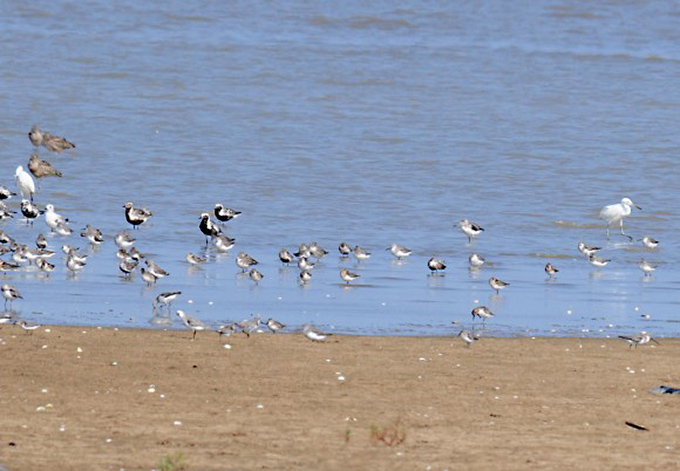
Songdo, August 30
On August 30th, I went back to Songdo and managed to (distantly) photograph the Asiatic Dowtcher.
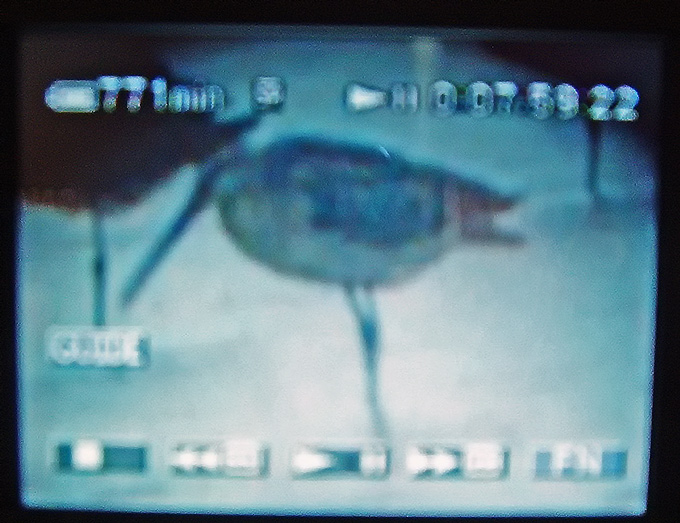
Yongjeong Island, August 25
At Yongjeong 23 + Black-faced Spoonbill along the south coast, where also at least 15 taivana Yellow Wagtail and some 40+ leucopsis White Wagtail in a restless group: noteworthy here was a juvenile Tiger Shrike in bushes and eg a juvenile Eurasian Cuckoo.
At Yongyudo, another 10+ Black-faced Spoonbill and several Chinese Egret. On the shrimp ponds, the regular family of Common Kingfishers. Among the waders, seasonal firsts included 11 Pacific Golden Plover, a Long-toed Stint and nice looks at a Red Knot. Most unexpected in nearby trees, a Lesser Cuckoo.
Unfortunate roadkill here was a Short-tailed Mamushi Gloydius blomhoffi brevicaudus, which was about 70cm in length, rather fat, with a short tail and prettily semi-circular markings. Briefly on the 26th at the lagoon in Incheon, a lone Spotted Redshank was the first of the season, making a summer-time total of 111 species.
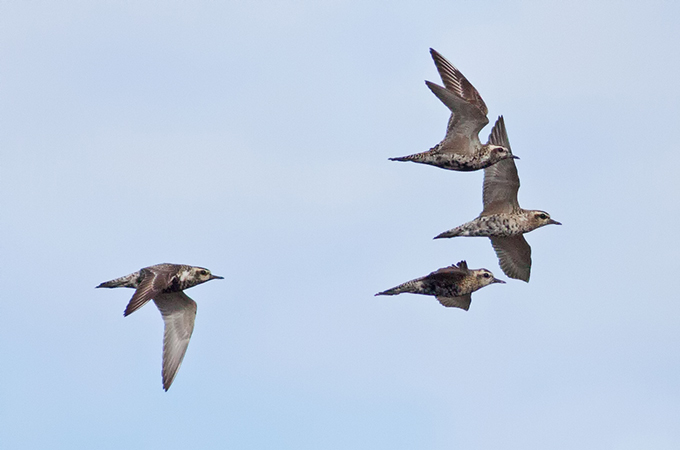
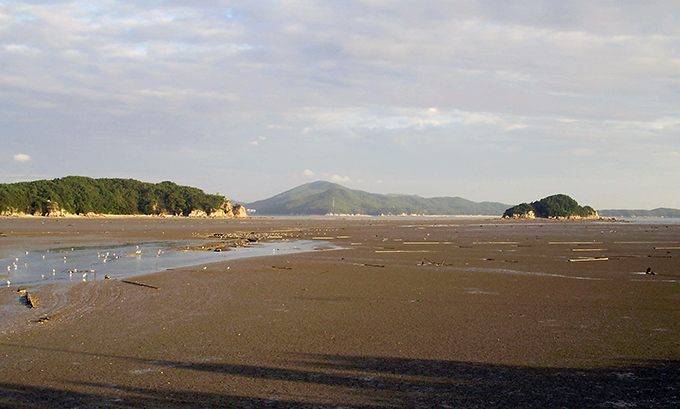
Geum River, August 19
In stifling heat, highlights at the Geum barrage included a half-dozen Marsh Sandpiper and best of all a Eurasian Eagle Owl!
Aham-do, August 19
At Aham-do a late afternoon of outstanding birding. After accidentally stumbling upon the main wader roost- in a hithertoo unseen area of mudflat, I was thrilled to see well through the scope a juvenile Asiatic Dowitcher! Although too far to be adequately photographed, I took time to sketch its features for later identification, when distinguished from Long-billed Dowitcher by a combination of overall slender structure, with apparent longish neck; straight, thick, jet-black bill and length thereof; relative size, clearly gauged in the field as intermediate between close-by Greenshanks and Black-tailed Godwits; dark, blackish cap contrasted with whitish supercilium and well-marked blackish eye-stripe, and the hue, pattern and extent of pale buff on the breast. The sudden, distinct sight of an Asian dowitcher among the assorted waders has been a dream come true- long awaited by those of us who have spent time birding at Songdo!
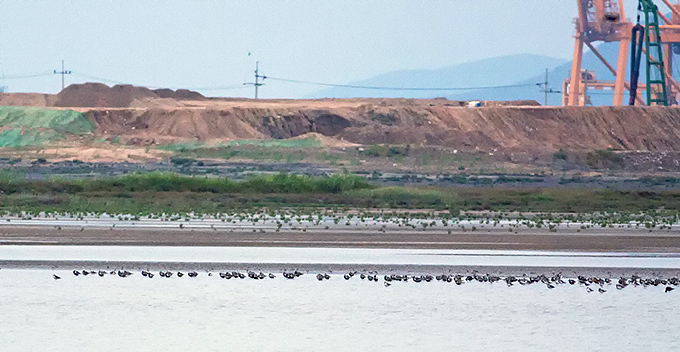
This was also followed by such notable migrants as a Ruff and Curlew Sandpiper. There were other seasonal firsts too; a single Garganey, 6 Grey-tailed Tattler, 2 Mongolian Plover, a Broad-billed Sandpiper and 4 Dunlin. Among a strong gathering of 200 + Barn Swallow were at least 5 Sand Martin; on reclaimed land, a Zitting Cisticola and Eurasian/ Far Eastern Lark.
Also on the estuary, a Mallard, 80+ Red-necked Stint, 160 Grey Plover, 57 Black-tailed Godwit, 6 Marsh Sandpiper, 2 Common Sandpiper, 15 Whimbrel, 6 Far Eastern Curlew, 29 Black-faced Spoonbill, 10 (juv) Saunders’s Gull, 310 Common Greenshank, 6 Terek Sandpiper, 2 Little Tern, 1 Eurasian Curlew, several Bar-tailed Godwits & 1 Common Redshank.
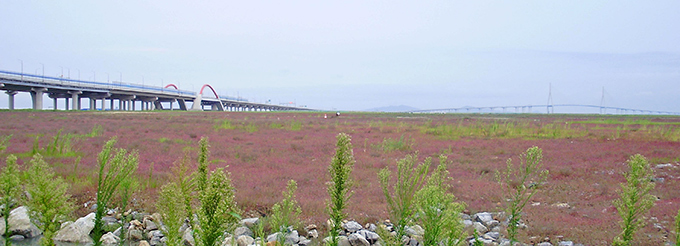

Yubu Island AM, and Gunsan-Eocheong Ferry PM, August 18
An outstanding day with multiple highlights.
On Yubu, shortly after first light, distant views of a juvenile Spoon-billed Sandpiper were followed by excellent scope views of a breeding plumaged adult (images will follow once JL returns to the mainland), and a brief encounter with a distant different juvenile or ‘breeding into non-breeding-type’.
Within the same hour, another outstanding moment came with finding an adult male dealbatus “White-faced Plover” in post-breeding plumage. Although digi-scope images were attempted, none were successful. However, identification (in more or less direct comparison with nihonensis Kentish Plovers) was straightforward based on its clean white lores, rust-toned rear crown, rufous-washed upper mantle and otherwise paler sandy-coloured upperparts, and its pale, yellowish-toned legs. This is likely to be the first record of this still poorly-known taxon in the ROK, and presumably the northernmost record. However, it comes only one or two days after JL photographed one or more intriguingly pale Kentish-types (again, images to follow at the end of the month).
After glimpsing one or more juvenile and adult Styan’s Grasshopper Warbler (breeding on one of the islets there), we then crossed back to the mainland in a strengthening wind, just in time to take the ferry out to Eocheong and back – in the hope of some seabirds. This turned out to be an excellent decision. Although most of the views were not so great, we managed to see c. 35 Streaked Shearwater, probably four Swinhoe’s Storm Petrel, and single Pomarine and South Polar Skuas…
Where else in the world can you see Spoon-billed Sandpiper, Black-faced Spoonbill, Styan’s Grasshoper Warbler, Swinhoe’s Storm Petrel and South Polar Skua on the same day, all within 50km of each other?
Yeongjong AM, Yubu Island PM, August 17
More of the same at Yeongjong on the falling tide, though with 80 Black-faced Spoonbill recorded (including one individually marked bird: E94 on a red flag on the left leg, and white over blue over yellow on the right leg). On Yubu in the Geum, excellent views of a good range of species during a neapish high tide, with probably 2,000 Far Eastern Oystercatcher, 2,000 Mongolian Plover, 1000+ Far Eastern Curlew, 1000+ Kentish Plover, 1,000 Terek Sandpiper and 800+ Broad-billed Sandpiper the most numerous species present.
Repeated checking of settled flocks found 30+ Greater Sand Plover, single Curlew Sandpiper and a distant Nordmann’s Greenshank, but no Spoon-billed Sandpiper. Returning semi-satisfied to the mainland, tiredness morphed into a mixture of frustration, anxiety and excitement as we heard from Birds Korea’s Jason Loghry (on the island for two weeks) that he had found and digi-videod a Spoon-billed Sandpiper close to where we were looking, only 30 minutes after we were forced to leave by the falling tide….
Yeongjong and Nami Island, August 16
Few birds found at Namiseom in oppressively humid conditions, with best being two Japanese Pygmy Woodpecker and Japanese Wagtail. Yeongjong was rather better. Despite much ongoing habitat loss (including the “beautification”, i.e. destruction, of the former shorebird roost-site) most of Korea’s tidal-flat specials could still be found, including 20+ Black-faced Spoonbill, 25+ Chinese Egret and 25+ Saunders’s Gulls (>10 juveniles), and a few thousand shorebirds. Most numerous included Far Eastern Curlew (400+) and Terek Sandpiper (800+), with a single Nordmann’s Greenshank providing the evening highlight.
Songdo, August 11
At Songdo Lagoon, notably 21 Common Redshank: there were several new faces, including 3 Little Grebe (raised here?), 5 glossy Black-winged Stilt, 4 Red-necked Stint, and several Wood Sandpiper.

The mudflat is mostly enclosed now by new walls. Still, 60+ Black-faced Spoonbill, and greatly swelled numbers of Grey Plover, far Eastern Curlew and Common Greenshank: also a Great Knot, rising numbers of Bar-tailed and Black-tailed Godwits, c.250 Great Cormorant. A Ruddy Turnstone and two Terek Sandpiper are the firsts of the season.
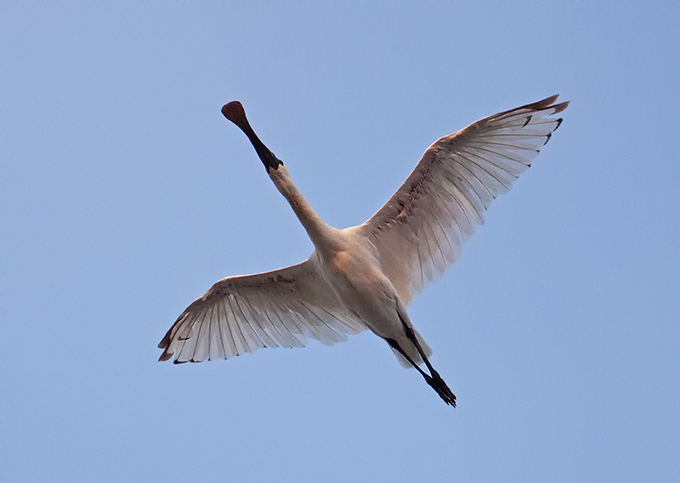
Igidae, Busan, August 11
Within three hours of looking at sea, more than 1000 Black-tailed Gulls, more than 100 Streaked Shearwater, about 75 Common Terns, about 150 Red-necked Phalarope, and a Pomarine Skua.
Geomam, August 3
At Geomam in a sweltering, humid 34 degrees, little to be seen, although a Grey-headed Green Woodpecker, Striated Heron and Eurasian Kestrel were new for this site.
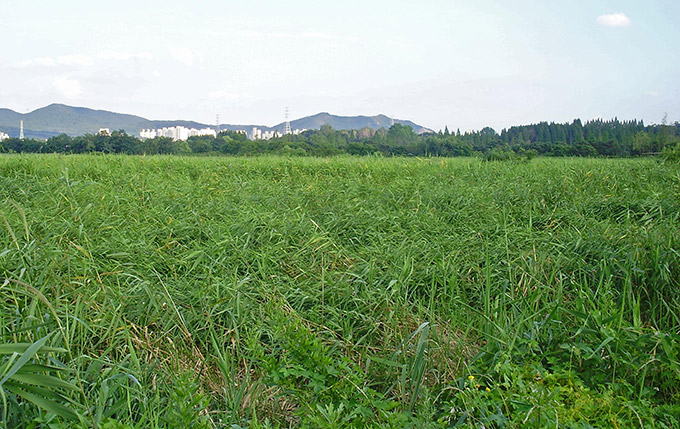
At dusk, a family of 5 Dollarbirds and 4 Hobby emerged to hawk insects together over the reedbed, making quite a spectacle, – with the rollers fluttering up and plunging down again in clumsy and erratic lunges.
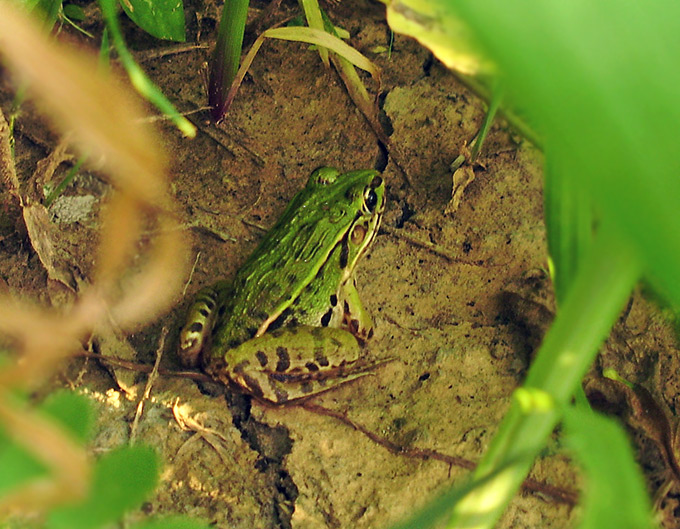
Busan, August 1-2
On August 1st, Jason Loghry and NM watched an adult Greater Crested Tern Thalasseus bergii offshore from Igidae, Busan. Although it was too distant to take a photograph, the bird was easily identified on ‘scope views by its large size (estimated at the time as about 20-30% less bulky than Black-tailed Gulls Larus crassirostris), long yellowish bill, and plumage (familiar to NM from previous experience of the species in e.g. Australia, Indonesia and Japan). It was mostly dark grey on the upperparts, contrasting with a much paler area on the primaries; and also with black on the rear-crown and white extensively across the forehead. It was watched for five minutes as it stole fish from Black-tailed Gulls (successfully or otherwise!), before it flew southwards towards Oryuk Do (Nam-gu, Busan). A short taxi ride later it was briefly re-found by NM. On August 2nd, presumably the same bird was again seen (again briefly and at long range!) by NM – this time about 2km south from Oryuk Do, again with Black-tailed Gulls.
This appears to be only the second record of Greater Crested Tern in the Republic of Korea. The first record was of up to 30 off Jeju Island in July 2011 found by researchers from the Ministry of Environment (and reported in Jeju news media: see http://www.jejuweekly.com/news/articleView.html?idxno=1733). An earlier record (from July 1917) referred to in the Jeju article was from Austin’s 1948 “Birds of Korea.” Although included by Austin, he considered the record doubtful. Based on the account in Kuroda used by Austin, this record was also likely from present-day Hwanghaenam Province (DPR Korea) – and not from the ROK. Moreover, based on the location, it would also seem more likely to refer to the now Critically Endangered Chinese Crested Tern Thalasseus bernsteini, which formerly bred on islands off the Shandong Peninsula, China, only 250km to the west.
Igidae, Busan, August 1
From a fishing boat, an excellent day’s birding, with close encounters with two of 20 Swinhoe’s Storm Petrel, 200+ Common Tern (showing a range of bare part coloration), single Flesh-footed Shearwater, several hundred Streaked Shearwater, 600+ Red-necked Phalarope, a single Pomarine Skua and one or two South Polar Skua: the latter species the highlight for NM at least! With wonderful steering by the boat’s captain, we were able to approach one of the South Polar Skua’s closely – as it first rested on a buoy and then roosted on the sea – allowing Dr. Ertel to take an excellent series of images.
Birds Korea 1108 Ho, 3 Dong, Samick Tower Apt., 148-22, Namcheon-Dong, Su-Young-Gu
Busan, 618-762 Republic of Korea





